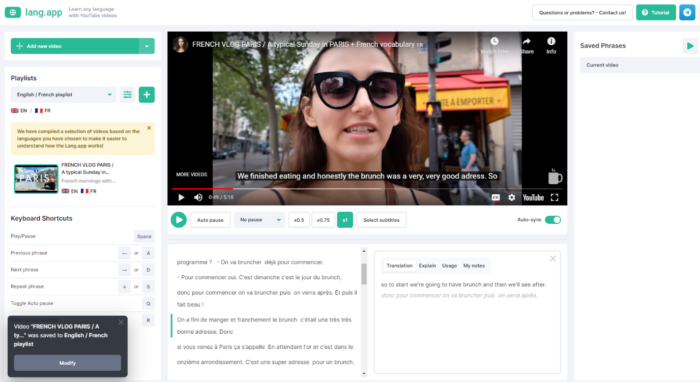5 Ways to Learn Languages with Native Speakers
Read other articles:
Back to posts
Table of Contents

If you’re learning French and aspiring to a high level of fluency, few things beat a trip to Paris and a few days speaking nothing but French in the city’s cafes, art galleries, shops and brasseries.
Language expert Stephen Krashen said:
“In the real world, conversations with sympathetic native speakers who are willing to help the acquirer understand are very helpful.”
Whether the people you meet in the Paris Metro will be “sympathetic” is debatable but the interactions and conversations you have there could certainly help!
For language learners trying to reach an advanced proficiency level — and who have hit a roadblock in “stepping up” their learning — it’s especially important to seek the help of native speakers.
But how can you interact regularly with native speakers if you can’t take that trip to Paris — or you’re learning Finnish and don’t fancy a trip to Lapland in the middle of winter?
Unless you have a “bestie” who’s a native speaker of your target language and is sympathetic to your learning needs, interactions can be a big challenge.
These ideas should help…
Why learn with a native speaker?
Quickly, before we get into the ways to interact with native speakers, let’s just revisit why it’s so important to acquire language through exposure to native speakers:
- Native speakers talk at a natural pace that prepares you for “real-world” fluency
- Important cultural insights and context are often provided
- Correct pronunciations of words that you can mimic (like how a child learns)
- Frequent use of idioms, slang and colloquial phrases that prepare you for real-world usage
- Use of the latest expressions and what’s being used “on the street”
- Use of different dialects and local language variations
- Exposure to local mannerisms and gestures, e.g., the use of the head, arms, hands and other body language when communicating
- Exposure to unique sounds that are not translatable — for instance the “ahhh” sound in Japanese and some other Asian languages that signify agreement

5 ways to learn with native speakers
Not all language learning requires conversational practice and needs to center around speaking. Indeed, when you start out learning a language, the mere thought of a conversation with a native speaker is likely to make you “clam up”.
Yet speaking is the focus of many programs. Once you gain proficiency and confidence in the language, it may be a realistic way to improve but Stephen Krashen believes that more emphasis needs to be placed on input (specifically, compelling and comprehensible input) rather than output.
Instruction should be in the native language but learners acquire language most effectively by listening and reading as well as speaking and writing. The ways to interact with native speakers should, therefore, include “passive” as well as “dynamic” interactions. To put it another way, watching a video about ordering coffee in the target language can be as much help as ordering a coffee from a native-speaking barista in-person.
So, if you’re trying to gain more language fluency, how do you go about increasing your interactions with native speakers in a non-stressful way?
1. Facebook groups
Say you want to learn Spanish to a proficiency level that will help you when you move to Venezuela. It would be good to not only learn Spanish but Spanish with Venezuelan native speakers.
Because of the huge volume of Facebook users almost everywhere, simple searches on Facebook are likely to suggest groups with hundreds or even thousands of members in your target language.
Often, members are passionate about learning and helpful with recommendations about activities and events that can help you get exposure to the language.

2. Online language exchanges
If you can find the right language partner online, it could be a win-win where both you and your “partner” can learn from a native speaker — often with mutual goals.
For instance, you could introduce yourself and offer to teach students of your native language in return for interactions in your target foreign language. You might offer one hour of tuition in your native language for every hour provided in the foreign language you’re learning.
Dedicated apps can help you set up these language exchanges. Tandem is a good example, connecting you with native speakers who can help you learn your target language in exchange for learning your language.

3. The Polyglot Club
Polyglot Club was specifically created for language learners — with over one million members from around the world now among its ranks.
Unless you’re learning a very obscure language, you can likely connect with many native speakers through the club. Established in 2002, it claims to cover 7921 languages!
Want to learn Southern Azerbaijani? No problem. You can either search for people speaking your target language in your area and attend in-person events or seek help with learning your language online with corrections provided by native speakers.

4. The Meetup app
The Meetup app for Apple and Android helps people with similar interests organize online groups for arranging in-person and virtual events.
Language learners can enter their interest and location — something like “learning German with a native speaker in New York” — and be connected with others with similar interests or with those who can help you.
The “Identity and Language” category is popular on Meetup. There are many options. For instance, several groups in NY have been formed for learning German — with hundreds of members.

5. Chrome extension for YouTube videos
Another great way that the tech is helping language learners connect and interact with native speakers is through YouTube videos.
The beauty of YouTube is that there are videos in every language in the world — almost certainly covering topics of interest to you. You can identify videos of interest in the foreign language you’re learning, download our simple Chrome extension and get set to learn from a YouTube native speaker.
YouTube video is the perfect type of content to acquire language from according to Stephen Krashen — compelling content in a relaxed setting. Advanced learners can watch entire shows or documentaries and immerse themselves in the language this way.

With our extension, you can create a list of videos and, as you play them, identify quotes and phrases, translate them and save them to reference later. It makes learning a second language from video easy. Learn more about how to use it here.
Learning a language isn’t just about memorizing a set of grammar rules, words, letters and sounds. Videos expose you to the real-life culture, mannerisms and lifestyles of native speakers as well as the language. This greatly enriches the learning experience.
Learn languages with native speakers
Native speakers have learned the language from childhood and absorbed it within the culture. They are uniquely placed to help you as a second-language learner — and no amount of language instruction in your first language or audio course content can replace that.
Ideally, to increase your exposure to the target language and accelerate your fluency, aim for daily interactions with native speakers, one way or another.
For most of us, watching videos in our own time is a more practical way to learn than meeting up with native speakers either individually or in groups. If you have access to native speakers in person, go full steam ahead! If not, video learning is a great backup as you try to master a language.
Download our free Chrome extension now to start improving your language proficiency through YouTube videos.
Read other articles:
Back to posts
